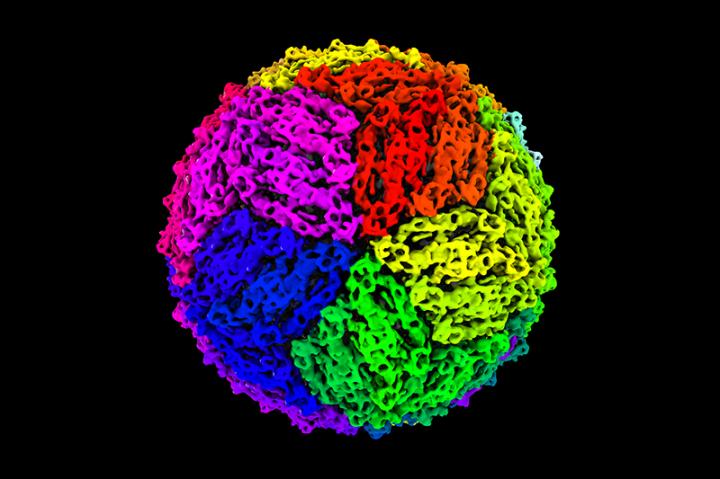Safer viruses for vaccine research and diagnosis

A 3D reconstruction of a chimeric viral particle. Proteins on the virus surface have been coloured using a rainbow gradient to represent the many possible viruses that could be presented using this system. This image, and all of the project's visualizations, were developed by UQ's Dr Daniel Watterson. Credit: Dr Daniel Watterson Usage Restrictions:To be only used with this story. Must be credited.
Researchers from UQ and QIMR Berghofer Medical Research Institute have exploited the benign characteristics of the Binjari virus – inert to humans – to produce 'dangerous looking' mosquito-borne viruses such as Zika and dengue, but which cannot grow in humans or animals.
School of Chemistry and Molecular Biosciences' Dr Jody Hobson-Peters said the team, led by Professor Roy Hall, began to explore this possibility after discovering new viruses in the lab.
“We were originally hoping to gain insights into how mosquito-borne viral diseases evolve – viruses like Zika, yellow fever and dengue,” Dr Hobson-Peters said.
“We were also hoping to discover new viruses that might be useful for biotechnology or as biological control agents.
“The Binjari virus stood out, and while it grows to very high levels in mosquito cells in the lab, it's completely harmless and cannot infect humans or other vertebrate species.
“And it is incredibly tolerant for genetic manipulation, allowing us to swap important genes from pathogenic viruses like Zika, West Nile and dengue into the Binjari genome.
“This produces hybrid, or chimeric, viruses that physically appeared identical to the disease-causing viruses under the electron microscope, but were still unable to grow in human or animal cells.”
The researchers have effectively developed a new biotechnology platform requiring low biocontainment, to help safely develop vaccines and diagnostics against these mosquito-borne diseases.
Professor Andreas Suhrbier, from QIMR Berghofer Medical Research Institute, said the team hoped to push this technology further down the development pathway toward human applications.
“The main advantage of this system is that it is safe,” Professor Suhrbier said.
“These hybrids cannot infect humans, meaning that manufacture of vaccines and diagnostic reagents don't require the strict and expensive biosecurity infrastructure ordinarily needed to grow these pathogenic viruses.
“The research is a testament to collaborative science – this all fell into place, with amazing collaboration within the Australian Infectious Diseases Research Centre.
“It's a technology that will truly revolutionise the manufacture of vaccines – supercharging high-volume vaccine development.”
###
The research has been published in Science Translational Medicine (DOI: 10.1126/scitranslmed.aax7888).
Media Contact
More Information:
http://dx.doi.org/10.1126/scitranslmed.aax7888All latest news from the category: Health and Medicine
This subject area encompasses research and studies in the field of human medicine.
Among the wide-ranging list of topics covered here are anesthesiology, anatomy, surgery, human genetics, hygiene and environmental medicine, internal medicine, neurology, pharmacology, physiology, urology and dental medicine.
Newest articles

Silicon Carbide Innovation Alliance to drive industrial-scale semiconductor work
Known for its ability to withstand extreme environments and high voltages, silicon carbide (SiC) is a semiconducting material made up of silicon and carbon atoms arranged into crystals that is…

New SPECT/CT technique shows impressive biomarker identification
…offers increased access for prostate cancer patients. A novel SPECT/CT acquisition method can accurately detect radiopharmaceutical biodistribution in a convenient manner for prostate cancer patients, opening the door for more…

How 3D printers can give robots a soft touch
Soft skin coverings and touch sensors have emerged as a promising feature for robots that are both safer and more intuitive for human interaction, but they are expensive and difficult…





















